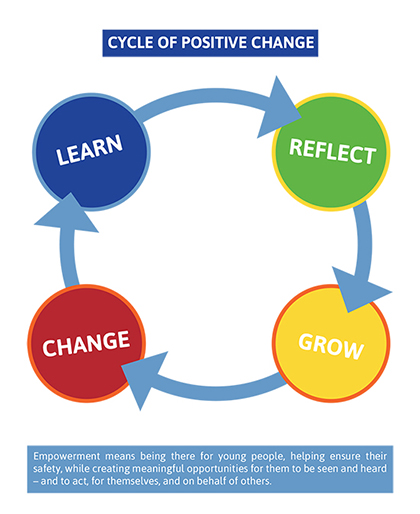What can teachers do to interrupt bullying?
Effective bullying prevention incorporates healthy and constructive communication as a central pillar. In other words, communication that respects the dignity and preserves the self-worth of all parties involved. By expressing oneself with these goals in mind, every person can preserve their own power while enabling others to do the same.
COMMUNICATING TO DE-ESCALATE BULLYING
When faced with a bullying situation, students who are bullied and potential allies often respond in one of several ways – passively, aggressively, or with revenge. Unfortunately, these strategies are rarely effective and may escalate or increase the bullying.
 When interrupting a bullying situation, we encourage strategies that address, de-escalate and interrupt the bullying. The following descriptions will assist us in helping students clarify the choices they are making when responding to bullying:
When interrupting a bullying situation, we encourage strategies that address, de-escalate and interrupt the bullying. The following descriptions will assist us in helping students clarify the choices they are making when responding to bullying:
- Passive: The student sends a message that they have no rights, and no power. Those who are bullying will continue to think that they are ‘in charge’.
- Aggressive: The student acts in a way that lets them take back or keep their own power by taking away someone else’s power. They do not respect the other person’s rights. Those who are bullying may think they have to bully even more to stay ‘in charge’.
- Revenge: The student seeks revenge hoping to “get even” and feel more powerful. The student who initiated the bullying becomes more aggressive in order to keep their power.
Standing apart from these common approaches is an alternative known as assertiveness:
- Assertive: The student sends the message that their rights are important. They keep their own power and also respect others’ rights. The student who bullies may find it hard to keep all the power for themselves.
Being assertive does not necessarily mean confronting the person who bullies. There are many ways to assert oneself and a variety of strategies that correspond to the above definition.
It is crucial for adults to recognize the enormous courage and creativity of students who make an attempt to stop acts of bullying, whatever the means they choose and whether or not the results are positive.

LISTENING TO EMPOWER
The positive influence that a teacher or other school staff member can have on the life of a student in distress cannot be underestimated.
Simply by listening, by showing respect and through an attitude of non-judgment, teachers and other school staff can offer comfort, reassurance and valuable support to a student. Such a positive impact may be the result of providing students with space and time to express their needs. For many students, such an experience may be a rare occurrence in their lives.
PROBLEM-SOLVING FOR EMPOWERMENT
Problem solving to address bullying -- or any problem-- is more effective when based on empowerment. This means that students are meaningfully engaged in the process of discussing the problem and generating their own ideas for developing an action plan to deal with it.
If we are striving to redress the imbalance of power in a bullying situation, and to encourage the positive and constructive use of personal power, it is important that we allow our students to have as much control as possible. We can do so by listening carefully and respectfully while providing adult guidance and support.

INTERVENTION WITH ALL PARTIES INVOLVED IN A BULLYING SITUATION
When responding to a bullying situation, it is important to adapt our approach based on the specific dynamics of the situation at hand, and the role each student played. With all parties involved, strategies that facilitate students’ empowerment while modelling the positive use of power - such as active listening and problem solving – are most effective.
Students who have been bullied need to feel and stay safe. It is important to clearly identify and denounce the bullying, and to let them know they were not responsible for what they experienced. Emphasizing the courage and strength they showed in seeking help while communicating a spirit of hope that things will get better are key.
When responding to a student who has witnessed bullying, we will need to identify what role the student has played. Those who did not support the bullying, as well as those who tried or wanted to stop the bullying, may need skills and encouragement to take action as allies in the future.
When responding to a student who initiated or supported bullying, we can encourage the student to assess, acknowledge and take responsibility for the consequences of their actions. It is important to clearly identify and denounce the bullying and its impact and to help the student find ways to repair the damage they have done.
In all situations, it is imperative to follow-up after the initial intervention. By following up, we send the following message to all parties involved: we truly care about the safety of the bullied student and we are committed to putting a stop to the bullying. By following up on the situation, we ensure that the student who has bullied continues to take responsibility for their actions.

LEARNING OPPORTUNITIES
When responding to a bullying situation, the goal is to encourage students to reflect, learn, grow and change. We want to avoid using shame and blame as a response, and instead encourage students who bully, or who support bullying, to reflect on their actions, take responsibility, take steps to repair the damage done, and then accept the natural consequences of their behaviour.
Teachers can help students learn more about respecting differences, building healthy relationships, engaging in constructive interactions and becoming a positive member of their community - even a positive leader and ally.
For more information and ideas about practical ways that teachers can intervene effectively in bullying situations, including COPA’s « Problem-Solving Tool for Empowerment », visit safeatschool.ca
